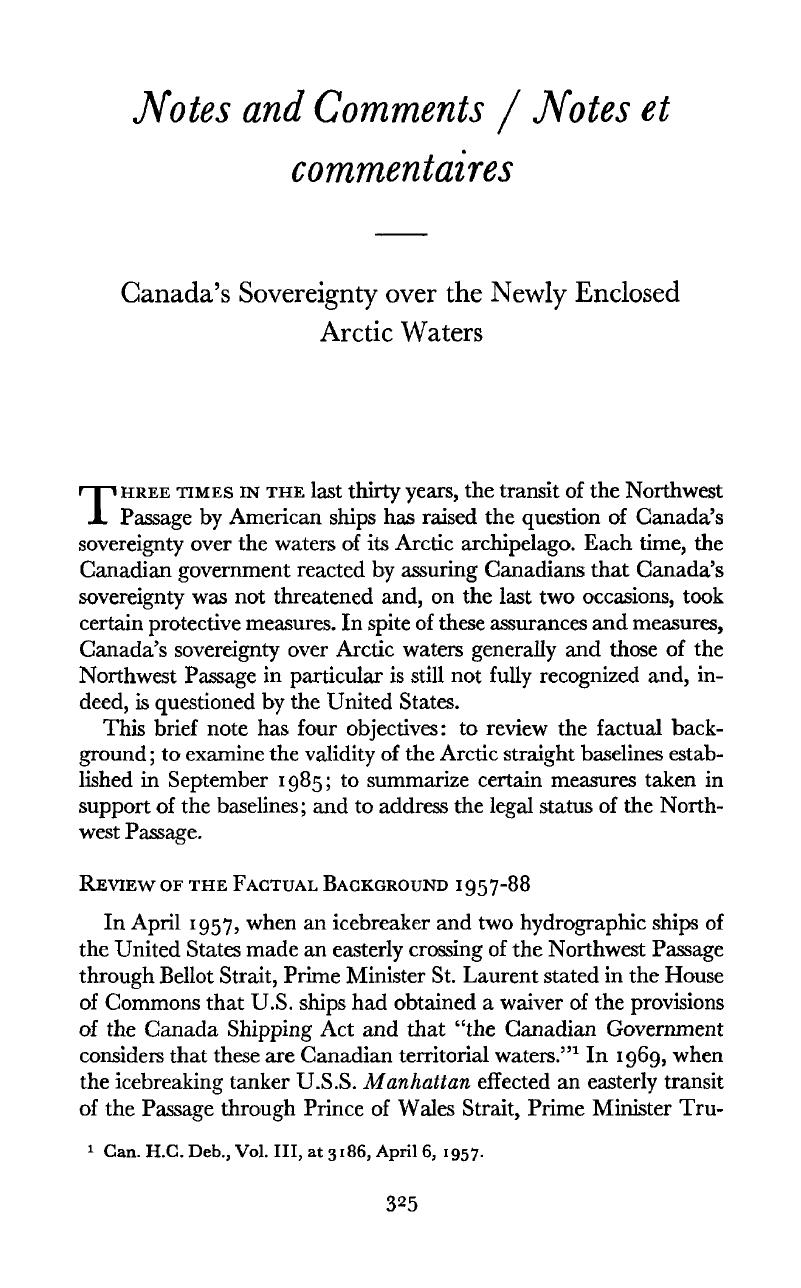Published online by Cambridge University Press: 09 March 2016

1 Can. H.C. Deb., Vol. Ill, at 3186, April 6, 1957.
2 “Canadian Sovereignty statement respecting the Arctic Archipelago, the continental shelf and inland waters,” Can. H.C. Deb. at 8720, May 15, 1969.
3 Ibid.
4 Bill C-203 to amend the Territorial Sea and Fishing Zones Act, April 8, 1970.
5 Arctic Waters Pollution Act, Chap. 47, 18-19 Eliz. II, 1969–70.
6 See Statement in the House of Commons by Secretary of State for External Affairs, Joe Clark, Sept. 10, 1985, reproduced in Statement Series, 85/49.
7 Ibid., 3.
8 Ibid., 4
9 Ibid., 5 .
10 Text provided by Department of External Affairs, at 1.
11 Transcript of Joint Press Conference, Jan. 11, 1987, No. MINP-511, at 3.
12 Vienna Convention on the Law of Treaties, Art. 32. It could even be argued that their statements might constitute binding declarations, on the basis of the importance attached to similar statements by the International Court of Justice in the Nuclear Tests case [1974] I.C.J. Rep. 253.
13 Ibid., Art. 31, para. 3(2) ; emphasis added.
14 For a detailed study of this legal basis, see Pharand, Donat, Canada’s Arctic Waters in International Law 89–130 (Cambridge University Press, 1988).CrossRefGoogle Scholar This book also examines the possible use of the sector theory as a basis for Canada’s claim (pp. 1–88). On the question of an historical title, see also Rigaldies, Francis, “Le statut des eaux de l’archipel de l’Arctique canadien,” 2 Collection Espaces et ressources maritimes 45–106 (1987).Google Scholar
15 For a fuller treatment than the present one, see Ibid., 131–84.
16 See Territorial Sea Geographical Coordinates (Area 7) Order, S.O.R./85–872, Canada Gazette, Part II, Vol. 119, No. 20, at 3996 (Sept. 10, 1985). These co-ordinates came into force on Jan. 1, 1986.
17 [1951] I.C.J. Rep. 116.
18 Ibid., 128–29.
19 Ibid., 133.
20 Ibid., 131.
21 For a review of state practice, see supra note 14, at 147–55.
22 Canadian Laws Offshore Application Act, Bill C-104, Sec. 14, April 11, 1986.
23 Ibid., Sec. 9.
24 Supra note 6, at 4.
25 Case No. 110-01-000306-83, Dec. 20, 1983, Transcript of the judgement of Judge Yvon Mercier, at p. 19.
26 For a description of the Polar 8, see Brigham, L.W., “A World-Class Icebreaker: The Canadian Polar-8,” 112 Proceedings, U.S. Naval Institute 150–52 (1986)Google Scholar and Pullen, T.C., “Why We Need the Polar 8,” Canadian Geographic 84–86 (April/May 1987).Google Scholar
27 National Defence, Challenge and Commitment: A Defence Policy for Canada (Ottawa, 1987).
28 Ibid., 51.
29 Ibid., 53.
30 For a description of the advantages of nuclear-powered submarines, see in particular an address by Vice-Admiral Thomas, C.M., Commander Maritime Command, to Conference of Defense Associations Seminar, A Maritime Response in Three Oceans (Ottawa, January 28, 1988, 13 pp.).Google Scholar
31 U.N. Treaty Series, Vol. 729, No. 10455, at 161.
32 See in particular Articles 14 and 34, Agreement between Canada and the IAEA for the Application of Safeguards in Connection with the Treaty on the Non-Proliferation of Nuclear Weapons, dated February 21, 1972, Canada Treaty Series, 1972, No. 3.
33 See, for example, Canada’s Agreement with India and the IAEA, dated September 30, 1971, Canada Treaty Series, 1971, No. 36.
34 It is presumed here that the exclusive economic zone is already part of customary international law, Canada not having yet adopted a full economic zone but only a fishing zone; otherwise these would have been high seas.
35 See the statement made by the legal adviser of the Department of External Affairs before a committee of the House of Commons: Standing Committee on External Affairs and National Defence, Minutes of Proceedings and Evidence, No. 25, at 18 ( 1970).
36 [1949]I.C.J.Rep.4.
37 Ibid., 29.